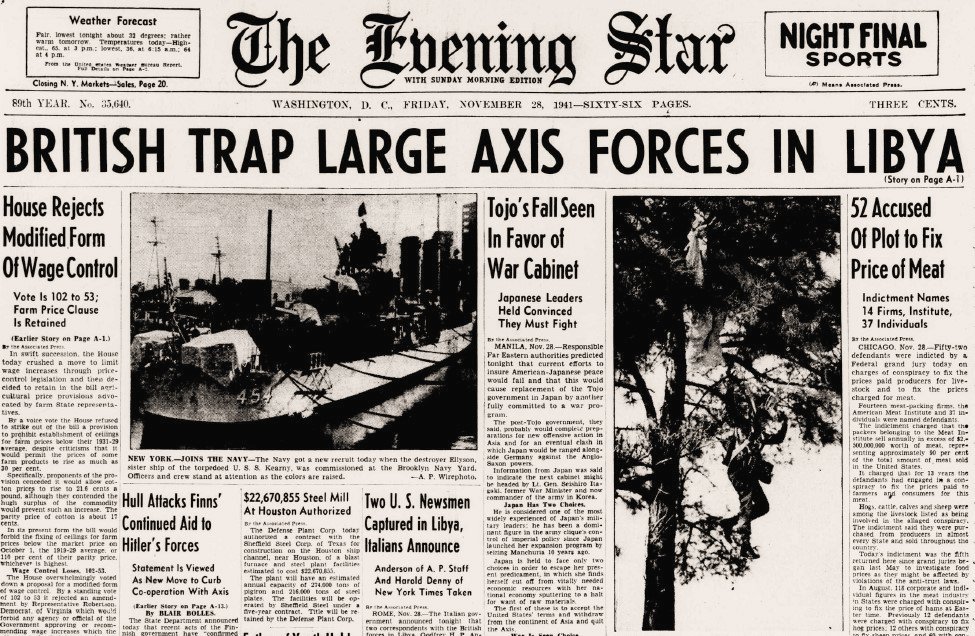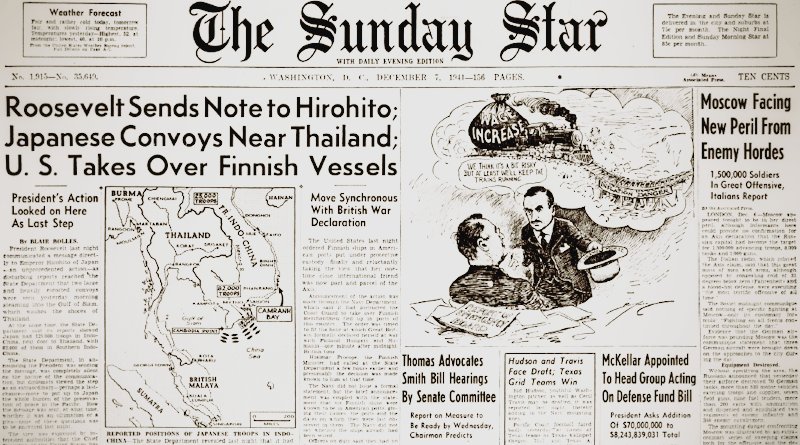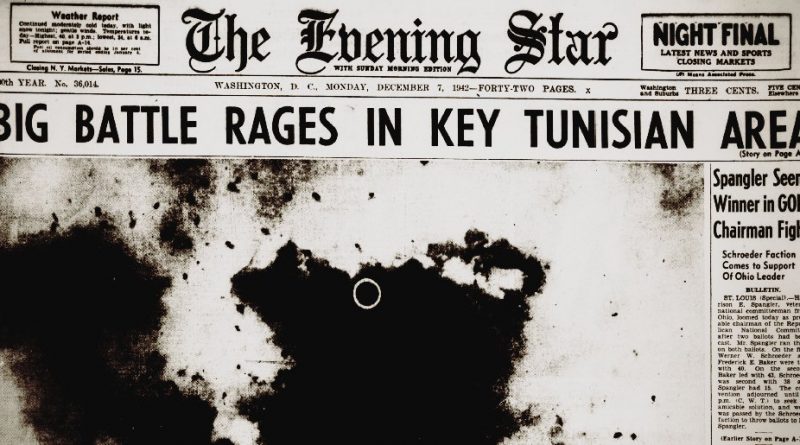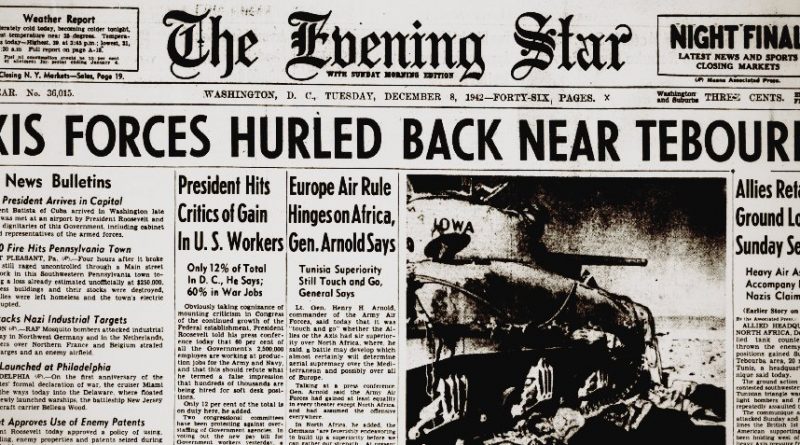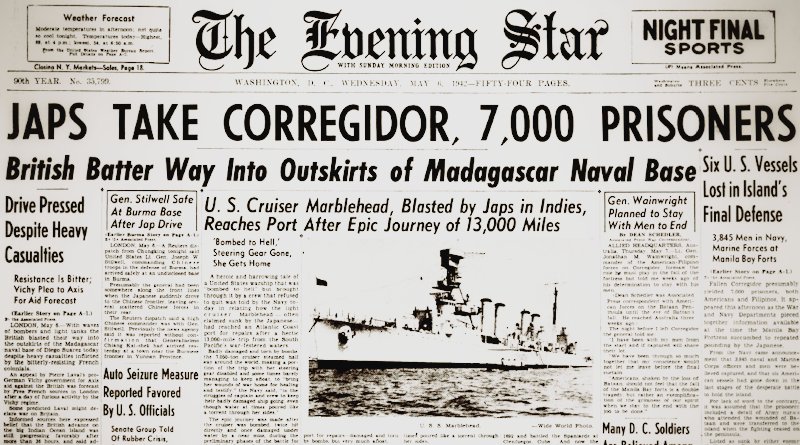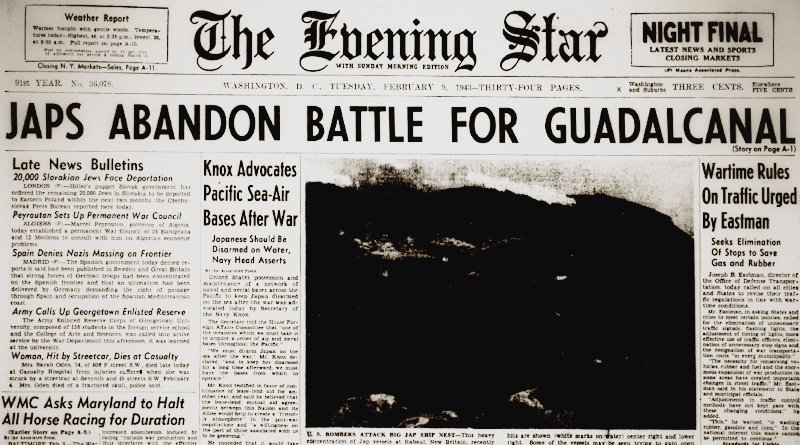World War II Chronicle: November 28, 1941
Click here for TODAY’S NEWSPAPER
EDITOR’S NOTE: By studying America’s role in World War II one day at a time, we can examine events more closely and sometimes from a different perspective than we otherwise would. 80 years ago today, men sat at typewriters preparing three documents for the crew of the aircraft carrier USS ENTERPRISE. Consider the gravity of the situation: with the United States and Japan clearly on the brink of war, ENTERPRISE and her task force were sailing 2,000 miles across the Pacific — and in fact would be closer to Japan than Hawaii. If you can imagine yourself a sailor aboard the carrier, these messages would have been quite unnerving to read as you sailed towards an Imperial Japanese Navy which outnumbers you, outguns you, and could be anywhere — ready to strike.
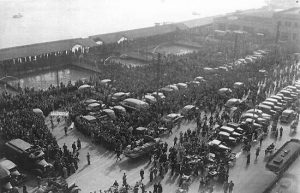
Page two reports the passenger liner SS President Harrison has departed Shanghai, sailing for an undisclosed location — actually Luzon Island’s Subic Bay — loaded with 700 men of 1st Battalion, 4th Marines and regimental staff. President Madison evacuated 2nd Battalion, 4th Marines from Shanghai the day before. The remaining 300 embassy and legation guards of the North China Marines are scheduled to be withdrawn by Harrison on Dec. 10.
On this day, 12 F4F-3 Wildcat fighters of Maj. Paul Putnam’s Marine Fighting Squadron 211 (VMF 211) lifted off on a secret flight from Marine Corps Air Station Ewa. The aviators mistakenly presumed they were just heading out for a training mission, but once VMF-211 is on board USS Enterprise, they learned they had been reassigned to Wake Island. Following Adm. Harold R. Stark’ s “war warning” issued yesterday and Vice Adm. William F. Halsey’s Battle Order No. 1 (see below), the task force is now operating under wartime conditions.
U.S.S. ENTERPRISE
At Sea
November 28, 1941
BATTLE ORDER NUMBER ONE
- The ENTERPRISE is now operating under war conditions.
- At any time, day or night, we must be ready for instant action.
- Hostile submarines may be encountered.
- The importance of every officer and man being specially alert and vigilant while on watch at his battle station must be fully realized by all hands.
- The failure of one man to carry out his assigned task promptly, particularly the lookouts, those manning the batteries, and all those on watch on the deck, might result in great loss of life and even loss of the ship.
- The Captain is confident all hands will prove equal to any emergency that may develop.
- It is part of the tradition of our Navy that, when put to the test, all hands keep cool, keep their heads, and FIGHT.
- Steady nerves and stout hearts are needed now.
G. D. MURRAY,
Captain, U.S. Navy
Commanding
Approved: November 28, 1941.
W. F. HALSEY,
Vice Admiral, U.S. Navy,
Commander Aircraft, Battle Force
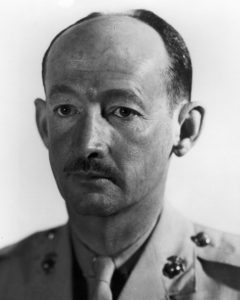
Meanwhile, the seaplane tender USS Wright (AV-1) arrives at Wake, disembarking officers and construction personnel to expand the remote facility into a naval air station. Wake already had a 5,000-foot-long runway, but none of the facilities necessary to support combat aviation operations. It’s aviation gasoline storage was not yet below ground, there was no hardened storage for warplanes, and with no PBY patrol planes — and no radar — “early warning” consisted of a watchtower atop a water tank, allowing observers to see just 10 miles away.
Cmdr. Winfield S. Cunningham (USN) relieved Maj. James P. S. Devereux (USMC), as overall commander of American forces on Wake but would be focused on overseeing the expansion; as officer-in-charge of the island’s detachment of the First Marine Defense Battalion, Devereux commanded the island’s defenses.
What were Halsey’s war conditions?
U.S.S. ENTERPRISE (CV6)
At Sea,
November 28, 1941.
CV6/A16-3(11-Kz)
BATTLE ORDER NUMBER TWO – 41
Subject: Supervisor – Instructions for.
- The Supervisor of the Watch will see that the following provisions for action against hostile craft are carried out whenever conditions warrant:
- a. Current developments have changed the “challenging” situation to some extent, in that we are now on a war basis and must be ready to open fire without hesitation should suspicious contacts be made.
- b. Carrier doctrine – for exercise or for war – still requires use of evasive tactics in all cases of possible hostile contact. ENTERPRISE must not disclose its presence by challenging or opening fire unless we are obviously being sighted or will soon be sighted. Fire emergency identification signal if ENTERPRISE comes under fire or appears in danger of being fired upon and immediately thereafter open fire if the correct answer to challenge is not properly made.
- c. If a submarine is encountered at close range immediately turn toward or away, depending on whether she is forward or aft of the beam. Open fire, and if turning toward, attempt to ram the submarine, unless she makes the proper recognition signal. In that case give submarine as wide a berth as possible and have plane guard check on identity.
- d. At night, if the plane guard fails to challenge when a contact with any unknown vessel, other than a submarine, is made, ENTERPRISE shall challenge immediately and open fire without delay, unless proper identification is made by the stranger.
- Until the return of ENTERPRISE to port, the Supervisor, as direct representative of the Captain, will consider all submarine contacts to be hostile vessels and will take immediate necessary action to avoid attack and will order fire to be opened when deemed necessary, without waiting for the Captain’s arrival on the bridge.
- Fire against aircraft, or vessels other than submarines, will not be opened without reference to the Captain, except when it is evident that an actual attack on ENTERPRISE is being made.
(Signed) G. D. MURRAY
Captain, U.S. Navy,
Commanding.
APPROVED, November 28, 1941.
(Signed) W. F. Halsey
Vice Admiral, U.S. Navy,
Commander Aircraft, Battle Force.
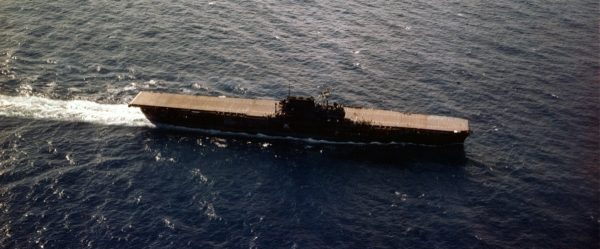
Were the planes and guns armed?
U.S.S. ENTERPRISE
November 28, 1941
MEMORANDUM FOR: SUPERVISORS and DECK WATCH OFFICERS.
Subject: Current information.
- AIRCRAFT:
- a. Readiness:
- 1. Normal Condition of Readiness of the Air Department is Flight Quarters or Condition III.
- 2. 4 VF planes in Condition II daylight to sunset.
1 VB plane in Condition II with 2 depth charges loaded. - 3. All VF, VB, VS, and VT planes on board are loaded to capacity with free and fixed gun ammunition.
- 4. Bombs are in ready condition in the magazines.
- 5. Torpedoes with war heads in ready condition in torpedo storage.
- 6. Every plane leaving the ship will carry 3 message droppers.
- 7. Plane sighting submarine will:
- a. Zoom it.
- b. Drop float light
- c. Open fire with machine guns
- d. Report position by radio ONLY in case it is evident no surface vessel’s attention has been attracted.
- a. Readiness:
- BATTERY:
- a. Readiness: – Fire Control is in Condition of Readiness III, with ready ammunition at the guns as follows:
- 50 rounds per 5″ gun
20 clips – 160 rounds per barrel – 1.1″ guns.
1000 rounds per barrel .50 caliber machine guns.
- 50 rounds per 5″ gun
- a. Readiness: – Fire Control is in Condition of Readiness III, with ready ammunition at the guns as follows:
- RADIO:
- a. Ship and aircraft will observe strict radio silence except for contacts. Merchantmen will be reported by aircraft message drops.
- b. A watch-in-3, Officer Watch, is being maintained in Radar Plot and the Radar instrument being continuously manned and operated, at prescribed intervals, day and night.
- SHIP CONTROL:
- a. Condition of Readiness III.
- b. At least once each watch all lookouts will be inspected to ascertain that men are familiar with sectors to be covered and clearly understand that they will not abandon search of their own sector when contacts have been reported in another sector.
- c. Control Officers will have their attention brought to the necessity of ascertaining that all battery officers understand their assigned sectors and are familiar with the location of own ships within those sectors.
- d. The Officer of the Deck will maintain current familiarity with challenge and recognition signals and require necessary changes to be made at times specified.
- e. The Supervisor, Officer of the Deck and Junior Officer of the Deck will keep themselves currently informed of the disposition and the location of ships therein.
- FLOATING OBJECTS:
- a. All floating objects whose character is in anyway uncertain should be avoided. Mines may be secured to dummy periscopes, water-logged boats, or to wreckage or to other objects or they may be tethered in pairs to floating objects.
(Signed) T. P. JETER
Commander, U.S. Navy,
Executive Officer.
CC: OOD Order Book
All Officers
Sports section begins on page 60, and on page 62 Green Bay Packers coach Curly Lambeau boasts that Clarke Hinkle is a better all-around fullback than the legendary Bronko Nagurski was. Nagurski called Hinkle “the toughest man I ever played against.” In fact, despite weighing 30 pounds less than his Chicago counterpart, Hinkle was the only player to ever knock “The Bronk” out of a game. He was either first- or second-team All-Pro every season of his decade in pro ball and he left the game as the NFL’s all-time leading rusher. He joins the Coast Guard, originally serving as a football coach for their academy, then convoy duty in North Africa, and later search-and-rescue. When he is inducted to the Hall of Fame, he is introduced by Nagurski.
1: One of Smith’s teammates is Steve Belichick, Navy football icon and father of NFL head coach Bill Belichick
2: Lt. Cmdr. Columbus D. Smith, USNR, had served as a commercial pilot for Wake and accepted a commission to remain behind with the boat and her crew.
Evening star. (Washington, D.C.), 28 November 1941. Chronicling America: Historic American Newspapers. Lib. of Congress.
https://chroniclingamerica.loc.gov/lccn/sn83045462/1941-11-28/ed-1/
